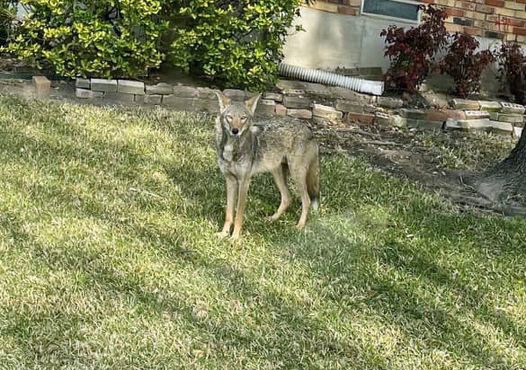
Meadowhill and Dartcrest. Graham Rucker.
Escalating coyote behavior seen at two East Dallas properties led officials to call a neighborhood meeting at Lakewood Branch Library this week.
The recent sightings occurred at 5919 Belmont Ave. in the Belmont Addition Conservation District and 5604 Willis Ave. in the Vickery Place Conservation District.
The home on Belmont Avenue is currently unoccupied. But neighbors say they have seen a coyote hanging out under the house, entering through the gaps left when the skirting was removed.
Construction has been paused by a stop work order from Building Inspection until the proper permits are acquired. However, Code Compliance Services is aware of the situation and will board up the base of the home if the homeowner doesn’t do so within a timely fashion.
Representatives from Dallas Animal Services and the Dallas Park and Recreation Department provided information to meeting attendees about urban coyotes and how to engage with them.
Trapping and relocating coyotes is not an effective solution, says Brett Johnson, an urban biologist at the park department, and killing coyotes should be a last resort.
Urban coyotes are not going anywhere. They’re generalists, which means they can survive in a variety of environments — everything from a forested area to a grassy patch in a city parking lot.
The best approach is to be proactive, rather than reactive, Johnson says. And in every scenario, Dallas should be keeping track of detailed reports of sightings, educating the public and enforcing ordinances.
There are also some things neighbors can do to help. Leaving pet food outside isn’t a good idea, Johnson says. Instead, just provide enough food for pets to eat in one sitting. Yard maintenance is also something to take into consideration; rodents are attracted to lush vegetation, especially during periods of drought, and coyotes and bobcats are attracted to rodents.
Intentional feeding of ducks could attract coyotes, too, because “ducks are terrible at cleaning up,” Johnson says.
In addition to these practices, Johnson says there are seven warning behaviors experts track to know how to respond to urban coyotes.
- Increase in observing coyotes on streets and in yards at night
Management strategy: Detailed reporting, education, ordinance enforcement - Coyotes approaching adults and/or taking pets at night
Management strategy: Detailed reporting, education, ordinance enforcement - Early morning and late afternoon daylight sightings of coyotes on streets and in parks and yards
Management strategy: Detailed reporting, education, ordinance enforcement and aversive conditioning, or hazing - Daylight observance of coyotes chasing or taking pets
Management strategy: Detailed reporting, education, ordinance enforcement, aversive conditioning, may begin to look for the animal, and some groups may start considering lethal removal - Attacking and taking pets on a leash or in close proximity to their owners; chasing joggers, bicyclists or other adults
Management strategy: Detailed reporting, education, ordinance enforcement, aversive conditioning, consider targeted lethal removal - Seen at mid-day around children’s play area, school grounds or parks where kids are actually present
Management strategy: Detailed reporting, education, ordinance enforcement, aversive conditioning, individual lethal removal - Acting aggressively toward adults in mid-day
Management strategy: Detailed reporting, education, ordinance enforcement, aversive conditioning, lethal removal of several animals
Hazing helps ensure coyotes don’t become too comfortable around people. A few hazing strategies include making loud noises, waving arms and spraying animals with water hoses.
If adults hide or stay quiet when a coyote is seen, it could encourage the animal to get close to people in the future.
Before the coyote attacked a child in Lake Highlands, it had approached kids and adults nearby. It had also injured a dog.
Coyotes learn quickly, and from each other. That’s why when behavior described in No. 7 is seen, officials might have to kill more than one animal.
City officials at the meeting say they are putting together educational materials to present to the public. They’re also working on an ordinance about feeding wildlife to bring to the Dallas City Council.





